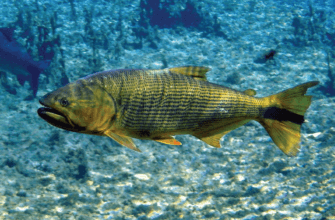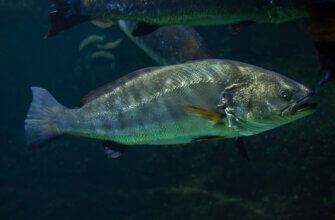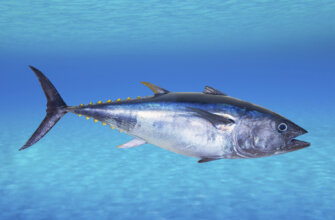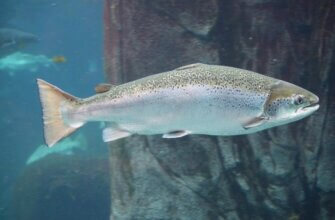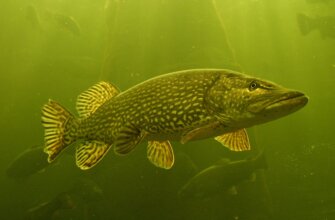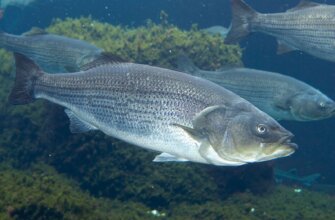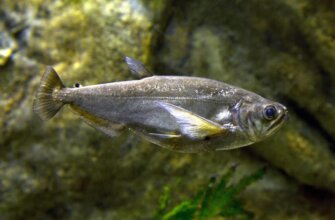Walleye, also known as Sander vitreus, is a species of freshwater fish that is highly prized by anglers and renowned for its delicious taste. It is native to North America and is widely distributed across the continent, particularly in the northern United States and Canada.
Walleye is a member of the perch family, Percidae, and is closely related to other popular game fish such as yellow perch and sauger. It is known for its distinctive appearance, with large, glassy eyes that reflect light, giving it its name. The eyes are adapted for low-light conditions, allowing the fish to see well in murky waters and during dawn and dusk, which are prime feeding times for walleye.
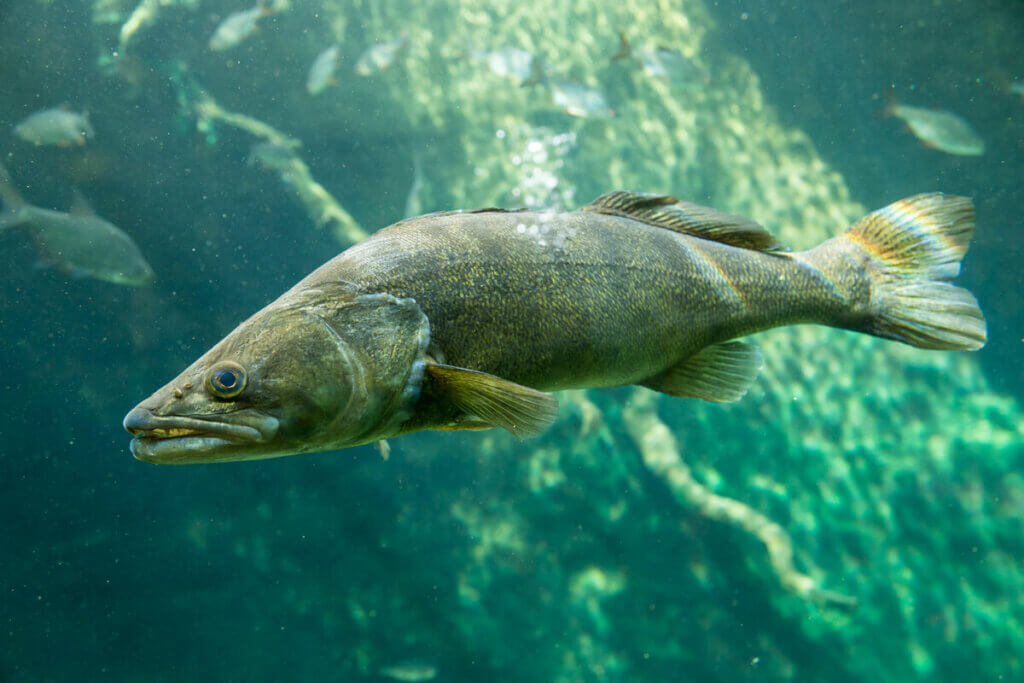
Walleye are primarily found in lakes and large rivers, where they inhabit a range of habitats, including rocky areas, submerged vegetation, and sandy bottoms. They are known to be highly adaptable and can tolerate a wide range of water temperatures and conditions. Walleye are most active during low-light periods, and they are known to move into shallow waters during the night or in overcast conditions to feed.
As carnivorous predators, walleye have a diverse diet consisting of various aquatic organisms. Their primary food sources include smaller fish such as yellow perch, shiners, and minnows. They also feed on insects, crayfish, and other invertebrates. Walleye use their excellent vision to locate their prey, often relying on ambush tactics and swift attacks to capture their meals.
Walleye are highly sought after by anglers for their sporting qualities and delectable flesh. They are known for their strong fight and are considered a challenging catch. Many fishing enthusiasts consider walleye fishing to be a rewarding experience due to the fish’s elusive nature and its preference for low-light conditions. Walleye are often targeted using a variety of techniques, including trolling, casting, and jigging.
In addition to being a popular sport fish, walleye is also a highly valued food fish. Its firm, white flesh is mild and flaky, with a delicate flavor that is highly regarded. Walleye is commonly prepared by baking, frying, or grilling, and it is often served as a centerpiece in regional cuisines across North America.
Due to their popularity, walleye populations are closely managed to ensure their sustainability. Regulations regarding catch limits, size restrictions, and fishing seasons are put in place to protect the species and maintain healthy populations. This helps to preserve the walleye fishery for future generations to enjoy.
Overall, walleye is an iconic freshwater fish known for its unique appearance, elusive nature, and excellent taste. Whether pursued by anglers or savored on a dinner plate, walleye holds a special place in the hearts of fishing enthusiasts and food lovers alike.
Appearance
Walleye have a distinctive appearance that sets them apart from other fish species. Here are some key features of the walleye’s appearance:
- Body Shape. Walleye have an elongated and cylindrical body shape. They are streamlined and have a slightly flattened profile from side to side.
- Coloration. The coloration of walleye can vary depending on their habitat and age. Generally, they have olive or gold-brown backs and sides that transition to a lighter color on their bellies. The sides of the walleye may have mottled patterns or blotches that help them blend into their surroundings. They also have a white or cream-colored underside.
- Eyes. One of the most distinctive features of the walleye is its eyes. They have large, reflective eyes that appear to have a glassy or translucent quality. The eyes are positioned on the sides of the head, providing the walleye with excellent forward and side vision, particularly in low-light conditions.
- Teeth. Walleye have sharp, canine-like teeth. Their teeth are well-adapted for capturing and holding onto prey, which primarily consists of smaller fish and aquatic invertebrates.
- Dorsal Fin. The dorsal fin of the walleye is divided into two parts. The front section has sharp spines, while the back section consists of soft rays. The spines can be erect or folded back depending on the fish’s behavior.
Overall, the walleye’s appearance combines its unique body shape, coloration, large reflective eyes, sharp teeth, and distinctive dorsal fin. These features contribute to its ability to thrive in freshwater environments and make it easily recognizable among other fish species.
Size and weight
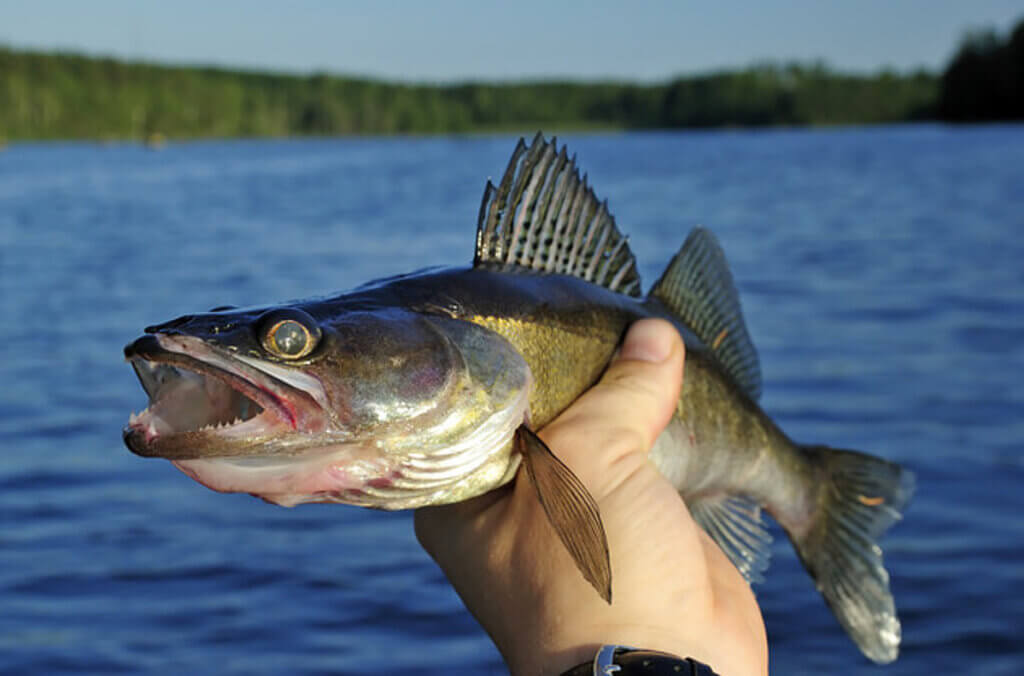
Walleye can vary in size and weight depending on factors such as their age, habitat, and food availability. Here are some general guidelines regarding the size and weight of walleye:
Size: On average, walleye measure between 14 to 26 inches (35 to 66 centimeters) in length. However, they can reach larger sizes. The maximum recorded length for walleye is around 35 inches (90 centimeters). It’s worth noting that there have been reports of walleye exceeding these sizes, but they are considered exceptional cases.
Weight: The weight of walleye also varies, but the average weight ranges from 1 to 3 pounds (0.5 to 1.4 kilograms). Larger individuals can weigh between 4 to 10 pounds (1.8 to 4.5 kilograms). The maximum reported weight for walleye is approximately 20 pounds (9 kilograms). Again, it’s important to note that walleye of exceptional size and weight are less common.
It’s worth mentioning that the size and weight of walleye can also be influenced by factors such as location and fishing pressure. In certain regions with optimal conditions and limited fishing pressure, walleye populations may have a greater chance to grow larger in size and weight.
Diet
Walleye are primarily piscivorous, meaning their diet mainly consists of other fish. However, their diet can also include a variety of other prey items depending on their habitat and availability.
Here are the main components of a walleye’s diet:
- Fish. Fish make up the majority of a walleye’s diet. They commonly prey on smaller fish species such as minnows, shiners, yellow perch, ciscoes, and other small baitfish. As walleye grow larger, they can consume larger prey, including their own species.
- Invertebrates. In addition to fish, walleye also consume a variety of invertebrates. This can include insects, crayfish, worms, and other aquatic invertebrates. Invertebrates are especially important in the diet of young walleye before they transition to a predominantly fish-based diet.
- Amphibians. Occasionally, walleye may consume small amphibians such as frogs and tadpoles, particularly if they are available in their habitat.
It’s important to note that the specific diet of walleye can vary depending on factors such as the availability of prey in their environment, seasonal changes, and individual feeding preferences. Walleye are known for their feeding activity during low-light conditions, particularly during dawn and dusk, as their large reflective eyes provide them with an advantage in low-light environments.
Behavior
Walleye exhibit various behaviors that are important for their survival and reproduction.
Here are some key behavioral characteristics of walleye:
- Nocturnal Feeding. Walleye are known for their feeding activity during low-light conditions, especially at dawn and dusk. They have excellent low-light vision due to their large reflective eyes, which gives them an advantage in locating and capturing prey.
- Ambush Predators. Walleye are ambush predators, meaning they rely on stealth and camouflage to surprise their prey. They often hide near structures such as rocks, submerged vegetation, or drop-offs and wait for unsuspecting prey to swim by. Once within striking distance, walleye swiftly engulf their prey.
- Solitary and Aggressive. Walleye are generally solitary fish, although they can sometimes be found in small groups, particularly during spawning season. They are known for their aggressive nature when it comes to feeding and defending their territory.
- Migration. Walleye may undertake seasonal migrations to spawn or find suitable feeding grounds. In many freshwater systems, walleye move from deeper waters to shallower areas with suitable spawning habitat during the spring. After spawning, they may return to deeper waters or migrate to areas with abundant prey.
- Sensitivity to Light. While walleye are primarily low-light predators, they are also sensitive to bright light. They tend to avoid well-lit areas and retreat to deeper waters or seek cover during periods of intense sunlight.
- Homing Instinct. Walleye have been observed to exhibit a homing instinct, returning to familiar areas such as their natal spawning grounds or favored feeding areas. This behavior allows them to navigate and locate suitable habitats for feeding and reproduction.
These behavioral characteristics contribute to the walleye’s success as a predator and its ability to adapt to various freshwater environments.
Spawning
Walleye undergo spawning, a crucial reproductive process that occurs during the spring in most freshwater systems.
Here’s an overview of the spawning behavior of walleye:
- Timing. The timing of walleye spawning varies depending on factors such as water temperature, photoperiod, and geographic location. Typically, it takes place when water temperatures reach a range of 45 to 55 degrees Fahrenheit (7 to 13 degrees Celsius), usually in the early spring.
- Spawning Habitat. Walleye seek out specific spawning habitats, usually in shallow areas with appropriate substrate. They prefer rocky or gravelly bottoms for egg deposition. These areas provide protection for the eggs from predators and ensure proper oxygenation.
- Male Territory Establishment. Prior to spawning, male walleye migrate to the spawning grounds and establish territories. They select an area that offers suitable substrate and water conditions. These territories are defended against other males and serve to attract females for spawning.
- Female Arrival and Spawning. Once the males have established territories, female walleye arrive at the spawning grounds. The females release their eggs, and the males simultaneously release their sperm, fertilizing the eggs externally. This process is known as broadcast spawning.
- Egg Development and Incubation. After fertilization, the adhesive eggs attach to the substrate, such as rocks or gravel. The eggs undergo a period of incubation, which typically lasts for a couple of weeks. During this time, the eggs develop and gradually transition into larval walleye.
- Larval Stage. After hatching, the walleye larvae remain attached to the substrate for a short period before becoming free-swimming. They start to feed on microscopic organisms and gradually transition to a diet of small aquatic invertebrates and fish as they grow.
- Post-Spawning Behavior. After spawning, both male and female walleye may move to deeper waters or transition to their preferred feeding areas. They recover from the spawning process and resume their normal feeding and behavior patterns.
It’s important to note that the specific details of walleye spawning can vary depending on the region and specific habitat conditions. However, the general pattern of male territory establishment, female arrival for spawning, and the subsequent development of eggs and larvae are consistent across their range.
Fishing
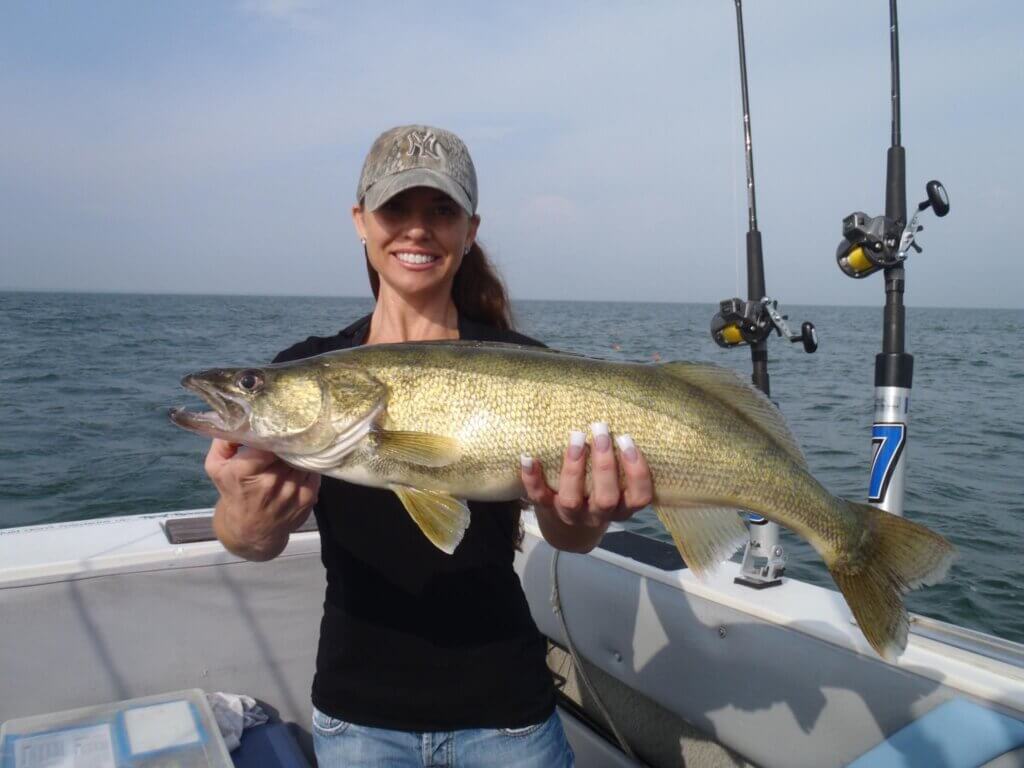
Fishing for walleye is a popular activity among anglers due to their prized status as game fish. Here are some tips and techniques for fishing walleye:
- Time of Day. Walleye are known to be more active during low-light conditions, particularly at dawn and dusk. Fishing during these times can increase your chances of success. However, walleye can still be caught throughout the day, especially in areas with suitable cover or structure.
- Location. Look for walleye in areas where they typically feed, such as drop-offs, rocky points, submerged structures, or weed edges. They tend to seek out areas with cover, such as fallen trees or vegetation, where they can ambush their prey. Pay attention to underwater structures and use fish finders or depth finders to locate potential hotspots.
- Bait and Lures. Walleye have a varied diet, so different baits and lures can be effective. Some popular choices include live bait such as minnows, leeches, or nightcrawlers. Jigging with minnows or using slip-bobber rigs can be productive techniques. Additionally, artificial lures like crankbaits, jerkbaits, spinnerbaits, and jigs in natural colors or patterns can entice walleye to strike.
- Presentation. When presenting your bait or lure, it’s essential to imitate the natural movement of prey. Slow and subtle movements often work best for walleye. For example, a slow retrieve or a gentle jigging motion can entice them to bite. Experiment with different speeds and depths to find the most effective presentation.
- Fishing Techniques. Depending on the conditions and preferences, various fishing techniques can be effective for walleye. These include casting and retrieving, trolling with crankbaits or spinner rigs, vertical jigging, and slip-bobber fishing. Adjust your technique based on the depth, structure, and activity level of the fish.
- Patience and Adaptability. Fishing for walleye can require patience and adaptability. Walleye behavior can vary depending on factors such as weather, water conditions, and seasonal patterns. Be willing to adjust your approach, location, and bait selection if needed to increase your chances of success.
- Local Knowledge. If possible, seek local knowledge from experienced anglers or fishing guides familiar with the specific walleye fishing opportunities in the area you plan to fish. They can provide valuable insights into seasonal patterns, productive spots, and effective techniques for that particular location.
Remember to adhere to fishing regulations, including size and bag limits, and practice catch-and-release whenever possible to help sustain healthy walleye populations for future generations of anglers.
Lures
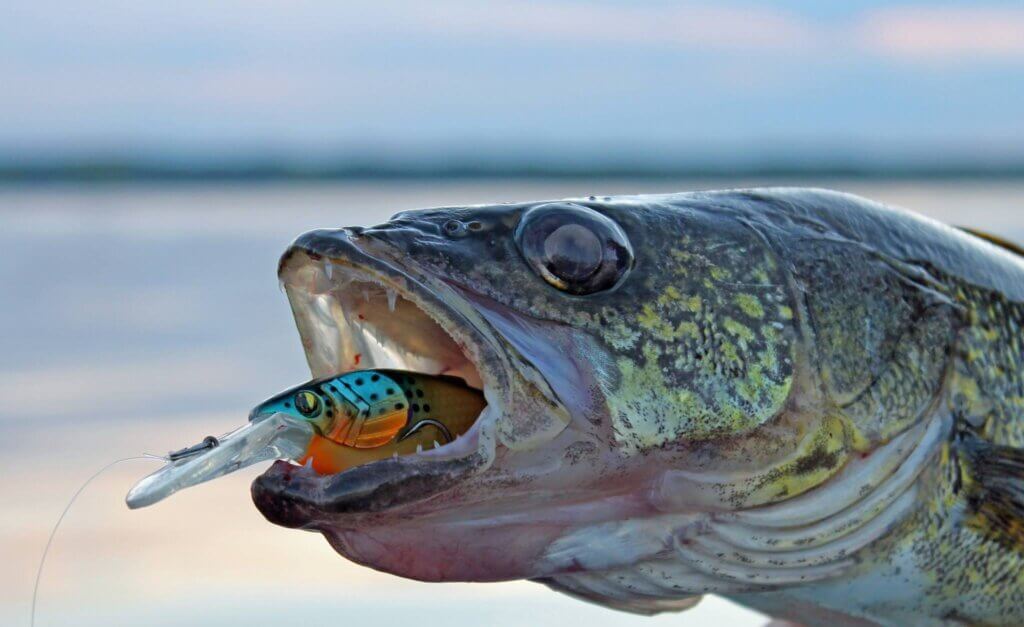
When it comes to lures for walleye fishing, there are several effective options to consider. Here are some popular lure types and styles that are commonly used for targeting walleye:
- Jigs: Jigs are versatile and widely used for walleye fishing. They consist of a weighted head with a hook and are often tipped with live bait such as minnows or leeches. Jigs allow for precise control of depth and presentation. Different jig colors, weights, and sizes can be used to match the conditions and preferences of the walleye.
- Crankbaits: Crankbaits are effective lures for covering water and triggering reaction strikes from walleye. These lures imitate injured baitfish with their diving and wobbling action. Shallow to mid-depth crankbaits are commonly used, and their color and size should match the forage in the area.
- Spinnerbaits: Spinnerbaits with a single or double blade can be productive for walleye. These lures create flash and vibration in the water, attracting walleye. Colorado or willowleaf blades are popular choices, and you can experiment with different blade colors and sizes. Adding a soft plastic trailer can enhance their effectiveness.
- Soft Plastics: Soft plastic lures such as twister tails, paddle tails, or grubs are often used for walleye fishing. They can be rigged on jigs, drop-shot rigs, or used with weighted hooks. The subtle swimming action and lifelike appearance of soft plastics make them enticing to walleye.
- Live Bait Alternatives: If live bait is not available or allowed, there are artificial alternatives that can be effective. Plastic minnow imitations, such as swimbaits or jerkbaits, can mimic the movement and appearance of live baitfish. These lures can be effective when worked slowly or with a stop-and-go retrieve.
- Blade Baits: Blade baits like the traditional “jigging spoons” are popular for vertical jigging. These lures have a metal body with a treble hook and a vibrating action. They work well when jigged vertically near the bottom or in areas with suspended walleye.
Remember to vary your retrieve speed, depth, and lure color to find what works best for the specific conditions and the walleye’s preferences. Additionally, it’s beneficial to have a variety of lure options available to adapt to changing fishing situations.
Local tackle shops or experienced anglers in the area you plan to fish can provide valuable insights on the most effective lure choices for walleye in that particular location and time of year.
Here are some examples of fishing lures for walleye, along with popular models and specifications:
- Jigs:
- Model: Northland Fishing Tackle Fire-Ball Jig.
- Weight: Available in various weights (e.g., 1/4 oz, 3/8 oz, 1/2 oz).
- Color: Assorted colors to match local forage.
- Features: Round head design, short-shank hook, bait keeper.
- Model: Northland Fishing Tackle Fire-Ball Jig.
- Crankbaits:
- Model: Rapala Shad Rap.
- Size: Ranges from SR05 (2 inches) to SR09 (3.5 inches).
- Color: Wide range of colors available.
- Features: Diving depth of 5-7 feet, realistic swimming action, rattling sound.
- Model: Rapala Shad Rap.
- Spinnerbaits:
- Model: Mepps Aglia Spinner.
- Size: Varies, e.g., Mepps Aglia #3 (1/4 oz).
- Color: Assorted blade and tail colors.
- Features: French blade design, stainless steel shaft, sharp treble hook.
- Model: Mepps Aglia Spinner.
- Soft Plastics:
- Model: Berkley PowerBait Ripple Shad.
- Size: Range of sizes available (e.g., 3-inch, 4-inch).
- Color: Assorted colors to match baitfish.
- Features: Ribbed body for lifelike movement, scent-infused, paddle tail design.
- Model: Berkley PowerBait Ripple Shad.
- Live Bait Alternatives:
- Model: Keitech Easy Shiner.
- Size: Options like 3-inch, 4-inch, 5-inch.
- Color: Various colors available.
- Features: Realistic baitfish profile, soft yet durable material, paddle tail action.
- Model: Keitech Easy Shiner.
- Blade Baits:
- Model: Johnson ThinFisher Blade Bait.
- Size: Range of sizes (e.g., 1/4 oz, 1/2 oz).
- Color: Assorted finishes and colors.
- Features: Vibrating action, lifelike finish, sharp treble hook.
- Model: Johnson ThinFisher Blade Bait.
Please note that these are just a few examples, and there are many other effective lures available on the market. When selecting lures, it’s essential to consider the specific conditions you’ll be fishing in, including water clarity, depth, and forage present. Experimenting with different sizes, colors, and retrieves can help you find what works best for walleye in your fishing location.
Baits
When it comes to baits for walleye, both live bait and artificial options can be effective.
Here are some popular baits for targeting walleye:
- Minnows: Live minnows are highly effective for walleye fishing. Common choices include fathead minnows, shiners, and emerald shiners. Hook the minnow through the lips or behind the dorsal fin to allow it to swim naturally.
- Leeches: Leeches are another popular live bait for walleye. Hook them through the sucker end or thread them onto a hook using a leech harness. Leeches have a natural swimming action that can entice walleye to strike.
- Nightcrawlers: Nightcrawlers or earthworms are readily available and can be productive for walleye. Rig them on a single hook or use a harness rig to present them effectively.
- Soft Plastic Grubs and Twister Tails: Soft plastic grubs and twister tails can be used as artificial bait alternatives. Rig them on a jig head or use them as a trailer on a spinnerbait. Opt for natural colors such as white, chartreuse, or black to mimic prey.
- Swimbaits: Soft plastic swimbaits imitate baitfish and can be effective for walleye. Choose swimbaits with a realistic swimming action and color patterns that match local forage.
- Spinner Rigs: Spinner rigs combine a spinner blade, beads, and a hook dressed with live bait or soft plastic trailers. They are versatile and can be trolled or casted. Customize the spinner rig with different blade colors and attractor beads.
- Crayfish: In areas with crayfish populations, using live or soft plastic crayfish imitations can be productive. Rig them on a jig head or use them as a trailer on a spinnerbait.
- Gulp! Alive! Baits: Gulp! Alive! baits are a popular choice among anglers. These soft baits are infused with scent and can attract walleye. Options like Gulp! Alive! Minnows, Nightcrawlers, or Leeches can be effective.
It’s essential to consider the local fishing regulations and bait restrictions in the area you plan to fish. Additionally, be prepared to adjust your bait selection based on the preferences of the walleye in that particular location and time of year. Experimentation and paying attention to the conditions and walleye behavior will help you determine the most effective baits for a successful fishing trip.
Rods
Selecting the right fishing rod for walleye fishing is crucial to ensure optimal performance and sensitivity.
Here are some factors to consider when choosing a walleye fishing rod, along with some popular models:
- St. Croix Eyecon Walleye Spinning Rod:
- Length: 6’6″ or 7′.
- Power: Medium-Light or Medium.
- Action: Fast.
- Features: High-modulus graphite construction, sensitive and lightweight, suitable for various walleye fishing techniques.
- Fenwick HMG Walleye Casting Rod:
- Length: 7′ or 7’6″.
- Power: Medium-Light or Medium.
- Action: Fast or Extra-Fast.
- Features: Carbon-bound rod blank, Fuji guides, ergonomic cork handle, suitable for casting and trolling applications.
- G. Loomis E6X Walleye Spinning Rod:
- Length: 6’6″ or 7′.
- Power: Medium or Medium-Light.
- Action: Fast or Extra-Fast.
- Features: Lightweight and sensitive graphite blank, Fuji guides, comfortable cork handle, designed specifically for walleye fishing techniques.
- Shimano Expride Spinning Rod:
- Length: 6’10” or 7’2″.
- Power: Medium-Light or Medium.
- Action: Fast or Extra-Fast.
- Features: High-modulus carbon blank, Fuji reel seat and guides, comfortable cork handle, designed for finesse walleye fishing techniques.
- Daiwa Tatula Elite Walleye Spinning Rod:
- Length: 6’9″ or 7′.
- Power: Medium-Light or Medium.
- Action: Fast or Extra-Fast.
- Features: Lightweight and sensitive blank, Fuji Alconite guides, comfortable cork handle, designed for walleye fishing with precise control and sensitivity.
These are just a few examples, and there are many other quality walleye fishing rods available on the market. When selecting a rod, consider your preferred fishing technique, the size of the walleye you’re targeting, and the specific fishing conditions you’ll be encountering.
Dishes
Walleye is a popular fish species known for its mild and delicate flavor. It is often cooked in various ways to highlight its taste.
Here are some delicious dishes you can make with walleye:
- Pan-Fried Walleye. Coat walleye fillets in a seasoned flour or breadcrumb mixture and pan-fry them until golden and crispy. Serve with lemon wedges and tartar sauce for a classic and simple preparation.
- Baked Walleye. Place seasoned walleye fillets in a baking dish and bake them until tender and flaky. You can add a topping of breadcrumbs, herbs, and butter for extra flavor.
- Grilled Walleye. Marinate walleye fillets in your favorite marinade, then grill them over medium heat until cooked through. The grill imparts a smoky flavor and creates beautiful grill marks.
- Walleye Tacos. Bread and fry walleye fillets, then serve them in warm tortillas with your choice of toppings such as shredded lettuce, diced tomatoes, sliced avocado, and a creamy sauce or salsa.
- Walleye Chowder. Make a creamy and hearty chowder by combining chunks of cooked walleye with potatoes, onions, celery, and corn in a flavorful broth. Serve with crusty bread for a satisfying meal.
- Walleye Sandwich. Bread and fry walleye fillets, then place them on a bun with lettuce, tomato, and your favorite condiments. It’s a tasty option for a quick and delicious meal.
- Walleye Cakes. Similar to crab cakes, you can make walleye cakes by combining flaked walleye with breadcrumbs, herbs, and eggs. Shape into patties and pan-fry them until golden brown. Serve with a sauce or dip of your choice.
Remember to check local fishing regulations and guidelines regarding catch limits and size restrictions for walleye in your area. Enjoy the flavors of walleye in these mouthwatering dishes!

